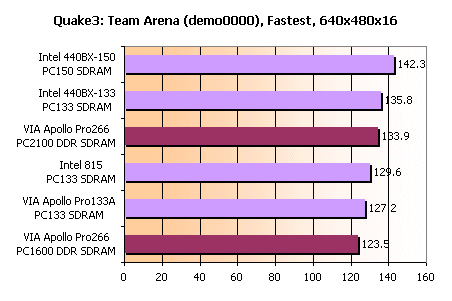De mannen van x-bit labs hebben een test online gezet over de VIA Apollo Pro266 chipset. De Apollo Pro266 chipset is geschikt voor Pentium III en Celeron processors en heeft ondersteuning voor DDR SDRAM (PC1600 en PC2100). Uit de benchmarks komt naar voren dat de Pentium III met DDR RAM een slechte combinatie is. In veel gevallen is de gewone i815 of BX chipset met een 133MHz FSB sneller dan de Apollo Pro266 met PC2100 DDR RAM. Als er gebruik wordt gemaakt van PC1600 geheugen met de Apollo Pro266 chipset is zelfs VIA's eigen Apollo Pro133A met SDRAM in veel gevallen sneller.
Deze tegenvallende resultaten kunnen verklaard worden door de lage FSB van de Pentium III. Met 133MHz is deze simpelweg niet snel genoeg om alle bandbreedte die DDR geheugen bied te benutten. Dit samen met het feit dat het geheugen asynchroon moet lopen zorgt voor een niet al te beste performance. De conclusie van de reviewer is dan ook dat DDR geheugen op het Pentium III platform alleen aantrekkelijk is indien de prijzen van DDR geheugen zover dalen dat het op SDR niveau komt:
To say more, since VIA chipsets work slower with the memory than Intel chipsets, very often VIA Apollo Pro266 turns out no faster than Intel chipsets supporting PC133 SDRAM. In general, we can state that systems on VIA Apollo Pro266 with PC2100 DDR SDRAM perform close to those on i440BX with the FSB overclocked to 133ÌHz. As for the same i440BX based platforms with a FSB clocked up to 150MHz and equipped with PC150 SDRAM, they are unreservedly faster than VIA Apollo Pro266 in almost all the tests. That is another striking demonstration of how important it is to increase the bandwidth of both memory and CPU buses.
As far as PC1600 DDR SDRAM on Pentium III platforms goes, our tests illustrate it clearly that the asynchronous work of DDR memory and CPU bus leads to outrageously poor results. Pretty often VIA Apollo Pro266 with PC1600 DDR SDRAM was even slower than VIA Apollo Pro133A. Now it is no longer surprising why most mainboard manufacturers give up the support of an asynchronous memory bus in their products.
As a final word, we wish to highlight the notable progress VIA has revealed in its newly made VIA Apollo Pro266 chipset. This core logic doesn't only support the high-performance DDR SDRAM, but is also the first representative of the chipsets with a new architecture featuring the innovative V-Link to connect the Bridges. Unfortunately, VIA didn't find the right application field for its new product. The systems on VIA Apollo Pro266 (with DDR SDRAM, of course) will hardly become a popular solution unless their price gets down and becomes more or less close to that of PC133 SDRAM systems.
 |
